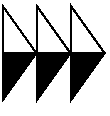 Research Institute for the Languages of Finland
Research Institute for the Languages of Finland
This document contains ISO 10646-1 (Unicode) characters which may cause problems and require (temporary)
changes in browser settings.
PostScript file of this document: Kotus-sz-hatut-EN.ps, 141 KB.
 Research Institute for the Languages of Finland
Research Institute for the Languages of Finland
The Finnish standard language can be considered to have reached its present stage at the end of the 19th century. As a result of conscious planning and goal-directed developing, the Finnish language reached the level of a civilized language that can be used in science, arts, and politics. It was also a hundred years ago that the present orthography of the Finnish language was established. Its basic principle is the correspondence between sounds and letters: each sound is marked with one letter and each letter means only one sound. The Finnish spelling system has been established and generally accepted. Thanks to it, it is easier and faster to teach the writing for instance in Finnish schools in comparison with many other cultures, in which the relation of pronunciation to spelling is more complicated.
In the Finnish language there is only one sibilant; it is not voiced and is marked with s. Thus all words containing other kinds of sibilants like [ʃ] (in the English word sugar) and [ʒ] (like in French jeune), are fairly new loans or proper names. In the languages in which these sounds occur, they are often marked in many different ways, and one sound may be marked with a combination of two or three letters (for instance English ship, machine, sugar; German Stein ‘stone’, schön ‘beautiful’; Swedish sjö ‘lake’, skön ‘beautiful’, stjärna ‘star’; French chauffeur ‘car driver’). This kind of practice is against the Finnish orthography. Because in Finnish writing one sound corresponds to one letter, it is necessary to use the characters š and ž, for instance in šakki, šaahi, šeikki, šillinki, tšeremissi, šamaani; džonkki, maharadža.
Due to technical reasons or for convenience, letter combinations sh and zh are often used in quickly or less carefully written texts. In Finland this is illogical and may even cause problems in interpretation. The characters s and h can occur successively in Finnish words, but then the sounds [s] and [h] belong to different syllables and the pronunciation is not [ʃ], (e.g. in compound words ihmishenki, virkamieshallitus, puoshaka, and in words like taashan, mieshän; compare also with pasha [sh] ‘a dish’, pašša [ʃ:] ‘a historical title’).
The letters š and ž are most often needed when foreign personal names or place names are written. For the transliteration of Cyrillic characters there is the international standard ISO 9. In Finland, the national standard SFS 4900 is generally applied. Also the Fifth United Nations Conference on the Standardization of Geographical Names in 1987 approved of the principles that are applied in transliterating the Russian Cyrillic alphabet. The system is intended for use in international publications, including English, French, German, Spanish, Finnish, or any other languages written in Latin characters. The purpose of the system is to clarify the writing of Russian names in international communication, to prevent confusion, and to fasten searches for instance in libraries. According to the approved principles of transliteration the Russian character ш is latinized with the character š (Шишкино - Šiškino) and ж is latinized with ž (Жужа - Žuža). The characters š and ž are also needed when writing the nomenclature of many other countries. According to the national usage and the national standard accepted in Finland, for instance the following names have to be written using the characters š and ž: Tšaikovski, Gorbatšov, Tšetšenia, Tšekki, Azerbaidžan, Brežnev.
Thus when Finnish language planners and usage advisors demand the use of the characters š and ž, this demand is based on the conditions set by the established orthography of the official language of the country. Such a situation is not acceptable in which, due to technical reasons, the people of some language area are forced to break the orthographic rules of their language and by so doing are forced to change the prevailing, established system. Instead, all technical and other means have to be used to further the possibilities of different cultures to develop and cultivate their languages as well as possible. Not depending on the mother tongue of anyone who uses ADP, it has to be possible to express oneself in writing in the way one wants to. In Finnish circumstances this requires the use of the characters š and ž.
Helsinki, 30 January 1998
Pauli Saukkonen
Prof., Ph.D., Director
Anneli Räikkälä
Department Head
References: